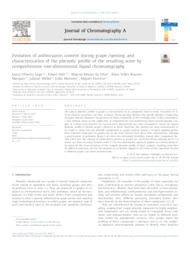Evolution of anthocyanin content during grape ripening and characterization of the phenolic profile of the resulting wine by comprehensive two-dimensional liquid chromatography.
Evolution of anthocyanin content during grape ripening and characterization of the phenolic profile of the resulting wine by comprehensive two-dimensional liquid chromatography.
Author(s): LAGO, L. O.; SWIT, P.; SILVA, M. M. da; BIASOTO, A. C. T.; WELKE, J.; MONTERO, L.; HERRERO, M.
Summary: Abstract: The typical phenolic profile in grapes is characterized by its complexity both in terms of number of diverse chemical structures and their variation during ripening. Besides, the specific phenolic composition of grapes directly influences the presence of those components in the resulting wine. In this contribution, a new method based on the application of comprehensive two-dimensional liquid chromatography coupled to a diode array detector and tandem mass spectrometry has been developed to obtain the typical phenolic profile of Malbec grapes cultivated in Brazil. Moreover, the method has been demonstrated to be useful to study how the phenolic composition in grapes evolved during a 10-week ripening period. Main detected compounds in grapes and in the wine derived from them were anthocyanins, although a good number of polymeric flavan-3-ols were also tentatively identified, among other compounds. Results show how the amount of anthocyanins present in grapes was increased during ripening up to 5-6 weeks and then decreased towards week 9. The two-dimensional approach applied was demonstrated to be useful for the characterization of the complex phenolic profile of these samples, involving more than 40 different structures and has the potential to be further applied to the study of this important fraction is different grapes and wines systematically.
Publication year: 2023
Types of publication: Journal article
Unit: Embrapa Environment
Observation
Some of Embrapa's publications are published as ePub files. To read them, use or download one of the following free software options to your computer or mobile device. Android: Google Play Books; IOS: iBooks; Windows and Linux: Calibre.
Access other publications
Access the Agricultural Research Database (BDPA) to consult Embrapa's full library collection and records.
Visit Embrapa Bookstore to purchase books and other publications sold by Embrapa.

